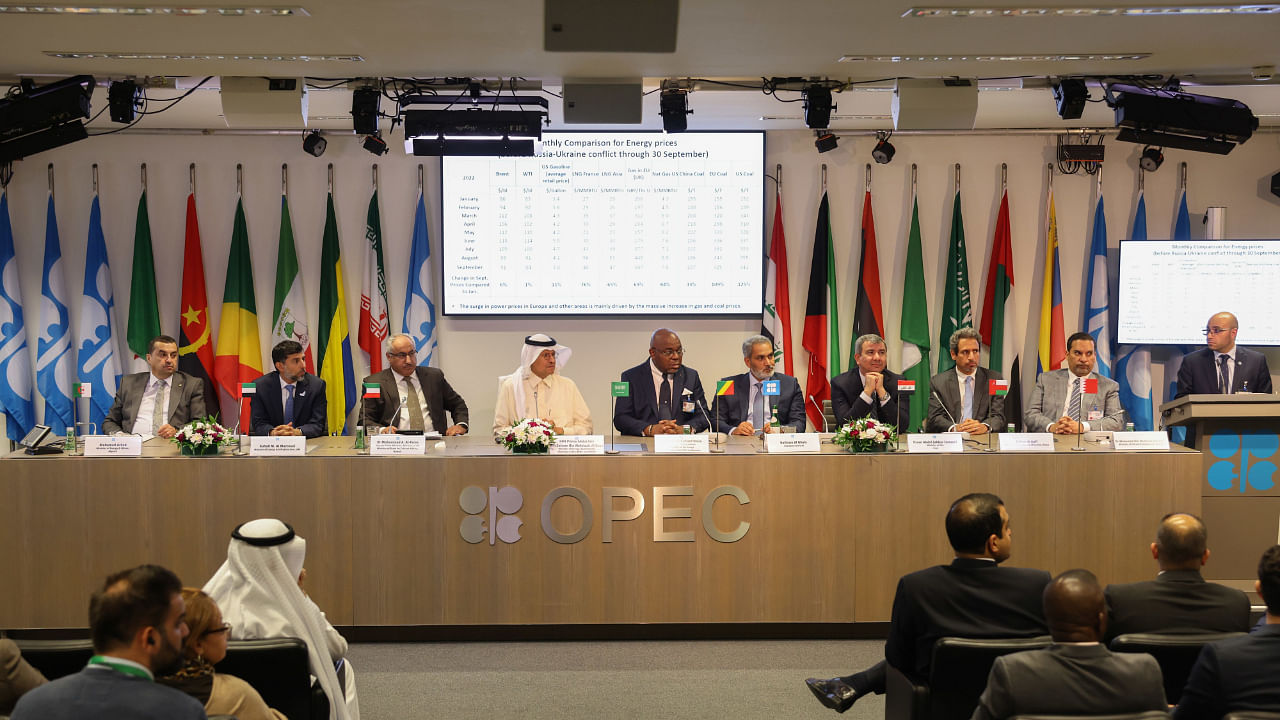
Ministers from the OPEC+ group of oil-producing countries agreed to cut their collective output target by 2 million barrels a day from November when they met on Wednesday. How much their actual production falls could be as little as one-tenth of the headline figure.
Although the group comprises 23 countries, the burden of the latest cut will be shared by just three — Saudi Arabia, the United Arab Emirates and Kuwait. Most of the others are already pumping so far below their quota levels that their output will still fall short of their new allocations.
Estimates of OPEC+’s September production suggest that, collectively, it’s lagging the planned level by about 3.6 million barrels a day.
When the new targets come into effect on Nov. 1, only eight countries will be required to pump less crude. In addition to the three Gulf Arab neighbors, small reductions should also come from South Sudan, Algeria, Gabon, Iraq and Oman.
The total reduction required of them is just 890,000 barrels a day. That’s still a significant cut, but a long way from the headline figure.
However, don’t expect the cut to be even that much. You can forget about South Sudan, Gabon and probably even Iraq.
OPEC’s own data show that South Sudan not only exceeded its quota every month since the current deal came into effect in May 2020, but that it never cut a single barrel of production. It would be surprising if it began now.
Gabon has shown a similar lack of resolve. Its output has been below its cap in just one month out of the agreement’s 29-month history, OPEC’s data show.
As for Iraq, the nation’s oil minister wasted no time after Wednesday’s deal was finalized to assure oil buyers that the agreement would not affect his country’s exports. With little room to tweak domestic use, that really means no cut in production either.
That whittles the list down to five.
The reductions required from Algeria and Oman total 32,000 barrels a day; that’s little more than a rounding error in the assessment of the group’s overall production.
The cuts required of Saudi Arabia and its neighbors amount to 790,000 barrels a day, but even that could be offset by increasing output from some other members of the group.
Nigeria, Angola and Malaysia are all contending with dwindling production capacity and have been pumping below their targets for many months. That’s not likely to change. Russia, too, is struggling. It was already finding it difficult to keep pace with its rising allocation before President Vladimir Putin ordered his troops into Ukraine, and the situation has only gotten worse in the months since the invasion.
But Kazakhstan is different. Output is running more than 560,000 barrels a day below target on a combination of planned maintenance at one of its biggest fields and a gas leak at another. The completion of the maintenance this weekend should allow the return of about 260,000 barrels a day. The rest will take longer, but the country’s energy minister says it should be back before the end of the month — just in time to offset the planned cut.
If he’s right, the effective output cut, measured from current production, could be reduced to as little as 230,000 barrels a day — hardly worth getting worked up about.
But a month later, the situation may look very different. European Union sanctions on Russian crude exports come into effect on Dec. 5 — the day after the producer group is due to hold its next meeting. The restrictions target most seaborne shipments to the bloc’s members, which have already dropped to about 660,000 barrels a day from 1.6 million barrels in January.
Russia has successfully diverted much of the crude shunned by European buyers to India, Turkey and China; but the sanctions, which also seek to limit shipments to non-European countries, could have a much bigger impact. Russia’s own fleet of tankers isn’t large enough to move all the oil that would need to be diverted from Europe. That could force production cuts. A proposed price cap on Russian crude would provide the Kremlin a way out — exempting from sanctions those cargoes sold at or below a yet-to-be-agreed price — but Moscow seems determined not to take it.
If the Kremlin decides to halt production instead of accepting a capped price, which seems likely, the OPEC+ cut of 2 million barrels a day could suddenly become very real.
One thing’s sure, crude’s on a roller coaster ride for the rest of 2022.